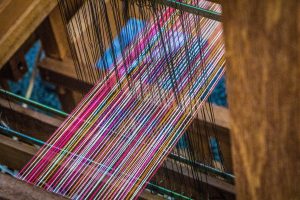The experience of going through EDCI 515 and 568 was one of intense devouring of information and applying it into our own personal practices. It has been quite a while since I have had to read this amount of academic material, and these courses have required that I grapple with the frameworks and apply them to my own practice, which has been informative and challenging.
I am glad that we took EDCI 515 early in the degree because it outlined the different methods that are used to capture and interpret information and frame it for the reader. At the start of July, there were many terms and concepts that had very little meaning for me. As the class progressed meanings and theories complimented the articles and began to weave themselves into each other and my way of thinking.
While looking through the research lens, I was surprised by the breadth of research methods, as they swung from solidly concrete into the wildly abstract. The pendulum of research typology is vast. For example, Understanding and Describing Quantitative Data by C. Lewin (2011) relies heavily on numbers and data to inform a conclusion. Whereas Meaning and Method: (Hermeneutic) Phenomenology is a Method, from Phenomenology of Practice by M. van Manen (2014) is a journey into understanding people’s inner process of wonder.

Photo by Charles “Duck” Unitas on Unsplash
The journey from concrete to abstract and the mixture of the two made me appreciate the necessity for a researcher to be able to look at information and data from multiple vantage points. There is not a right way and a wrong way necessarily but the ability to look at information from different perspectives allows a more defined illustration of the entire concept. I believe that technology has created this by letting everyone’s voice be heard. Sometimes this is a negative aspect, but having the ability to able to wade through the static using a subjective lens illustrates the larger picture.

Photo by Lawrence Macaron on Unsplash
In my own practice, I feel that it is essential to use an in-depth knowledge of different theories and blend them with the practical sides of our jobs. As mentioned earlier, the more lenses we use to view a situation, the more informed and educated our decision will become. Like the picture above, we have to weave our understanding of theoretical frameworks and integrate them into our classroom. With the shift towards schools becoming ungraded we have the opportunity to weave meaningful reflection and anecdotal feedback to our students to help them progress as learners. As the instructor of a classroom we have to become the researcher and be able to use a variety of methods to fully illuminate the progress of our students. This process includes concrete methods (graded, scaled, etc.) and understanding the underlying framework (context, annotative feedback, cultural background) of our students. This will give us the most informed information about how we can help them progress as students and human beings.
How can we bring these theories and frameworks to help parents become a more involved and engaged party? There is always going to be a division between parents who are always involved and the ones who struggle to stay engaged. I have primarily taught at vulnerable schools and I have seen issues with parent involvement and the effect it has on students. Ultimately, I believe that the groundwork has to made by engaging parents and building strong relationships.
Relationships play the number one role in my classroom. I believe that it creates a positive culture and environment. This allows me to get to know the students and learn the context that allows positive academic and personal growth for the students. By doing the ground work, laying the foundation and then identifying the direction that is best suited for the individual. I am able to do a type of action research, Getting To Grips With Perspectives And Models by Mary McAteer (2013).

Photo by Ashkan Forouzani 🇮🇷 on Unsplash
A theme that arose for me over this course was that research methods are vast and cover a wide range of theories and possibilities. Research methods have not considerably changed over time but are continuously transitioning into a modern and digital age as touched on in “The Digital Scholar Revisited” by M. Weller (2018). As discussed in Bonnie Stewart’s presentation, the type of studies that are completed and where the information is taken from is shifting. The largest shift is not how the information is collected but how the research is distributed and shared. We discussed this in detail during our presentation with John Willinsky. Knowledge and information will be more readily available to the general public with the growing voice of open scholarship. This will lead to our students being able to access more reviewed and trusted sources of information.
Like research methodologies, education has not changed drastically over the last century but there is an active struggle for education to complete its ideological shift into the 21st century. This is especially apparent in British Columbia, where the curriculum has changed to promote different ways of learning and teachers are encouraged to collaborate and continue to transform the paradigm of traditional schooling beliefs, values and practices.

Photo by Benjamin Davies on Unsplash
Inquiry learning is a type of learning that I connect with. Even with all of the presentations on inquiry learning and the benefits it can bring to a class, I have seen the impacts myself. I have tried it my class in small bits and mostly used it as part of passion projects for the students. As I was never taught this in university, I am just starting this part of my educational journey, and with the help of “Inquiry Mindset” by Trevor MacKenzie and the presentation by Jeff Hopkins (PSII) it has inspired me to implement this more into my classroom.
There are a couple key aspects that highlight the necessity of implementing this way of instruction into my own classroom. First, is the ability to make it an individual learning experience for each student. Being an elementary teacher the variety and scale of the students’ abilities in your class is shocking. As stated earlier, I believe that developing a relationship and knowing a student is vital. Through inquiry based learning, you can help the students tailor their own learning journey to adhere to their learning needs and interests. All students should know what succeeding looks like and how to show their learning. Second, is creating microenvironments and collaboration in our learning community. Allowing students to share their interests and skills through different subjects and collaboration can create a stronger learning community. Finally, I LOVE the idea of collaborating as teachers especially in the reporting on students. As a solo teacher, writing about a student’s progress sometimes raises doubts about whether you captured the full picture of a student’s progress. If that process was shared between teachers there would be a check and balance implemented, ultimately leading to a more informed report card.
Through the course, we have explored many ways that different theories and methodologies in technology can play a role in how we educate and teach.
How does this impact me and where do I go from here on my journey as an educator completing my masters?
I believe I have to become more educated as a digital citizen. If my goal is to promote parent engagement in their child’s education, I have to be the role model in how that can be accomplished. This is not an easy task. There are many issues ranging from crediting photos to their rightful owners to being more actively aware of privacy policies. There are many aspects of being a conscientious user, let alone an educator of how to responsibly use technology and the Internet, which are ever evolving.
While being mindful of what resides online, we also have to be on the forefront of utilizing the tools that can be used to benefit our students, families and learning community. Moving forward I want to use tools and different platforms to try to engage parents to create a relationship with the teacher and help guide them in becoming an active member of their child’s learning. I want to create that microenvironment of a team and generate a relationship where we can work together.

Photo by Samuel Zeller on Unsplash
However, we know that one shoe does not fit everyone. So how can we keep the participating engaged parents involved while engaging the parents who are continuously absent? There will always be the dichotomy of helicopter parents and “invisible” parents, which require a deeper inquiry in order to understand the underlying issues that, disrupt the parent’s ability to be involved in their child’s academics. In order to educate parents on the positive effects they could have on their children’s education, I think that it is essential to provide evidence and concrete examples that highlight accountability and communication. How do we get there? This is the question that needs to be answered moving forward.
This journey is a long and winding road but you have to start somewhere. As these classes have progressed I felt that I have been able to put down roots and have been able to start walking in the direction I want to head. Although, it may be a long journey we will be completing together as a cohort. We will be able to collaborate and support each other while we move forward. We just have to remember…one foot in front of the other.

Photo by Tegan Mierle on Unsplash

December 13, 2020 at 12:28 am
Hello, i think that i saw you visited my weblog thus i came to 搑eturn the favor?I’m attempting to find things to improve my web site!I suppose its ok to use a few of your ideas!!